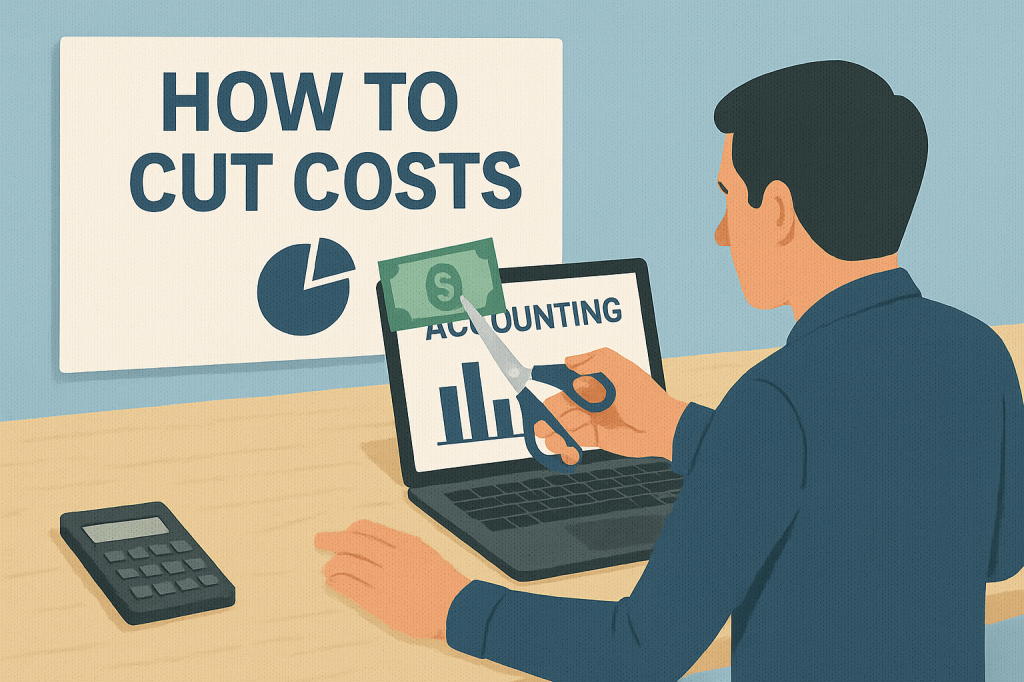As we approach the midpoint of 2025, small business owners, freelancers, and entrepreneurs are looking to tighten their belts and maximize profitability. With budgets under review and the second half of the year on the horizon, cutting costs effectively can ensure financial stability and growth. Accounting software is a powerful ally in this endeavor, offering tools to identify savings, streamline operations, and optimize financial decisions. '
In this article, we’ll dive into actionable strategies to reduce expenses using accounting software, focusing on practical steps to enhance your bottom line. Whether you’re managing a seasonal business or scaling operations, these tips will help you save money and thrive through the rest of 2025.
Why Cutting Costs with Accounting Software Matters
Reducing costs is a critical strategy for small businesses to improve cash flow, increase profit margins, and remain competitive in 2025’s evolving market. High overheads, inefficient processes, or overlooked expenses can erode profits, especially mid-year when resources are reassessed.
Accounting software empowers you to track every dollar, automate time-consuming tasks, and uncover hidden savings opportunities. By leveraging its features—such as expense monitoring, automated invoicing, and detailed reporting—you can make informed decisions to cut costs without sacrificing quality, setting your business up for long-term success.
Strategies to Cut Costs with Accounting Software:
Automate Invoicing to Save Time and Labor Costs
One of the easiest ways to cut costs is by automating your invoicing process. Manual invoicing eats up hours that could be spent on revenue-generating activities. Use accounting software to set up recurring invoices for regular clients, ensuring timely billing without constant oversight. Additionally, enable automated payment reminders to reduce follow-ups, minimizing administrative labor costs. For example, scheduling monthly invoices for a retainer client can save you several hours a month, translating to significant savings if you’re paying an assistant or yourself at an hourly rate.
Track and Categorize Expenses to Eliminate Waste
Keeping a close eye on expenses is key to identifying where you can cut costs. Accounting software allows you to import bank transactions automatically and categorize them into buckets like utilities, marketing, or supplies. Regularly review these categories to spot overspending—such as unused subscriptions or excessive travel expenses—and cancel or renegotiate them. For instance, a monthly review might reveal a $50 software subscription you no longer need, saving $600 annually. Upload receipts for all purchases to ensure tax-deductible expenses are documented, further reducing tax liabilities.
Negotiate Better Vendor Terms to Preserve Cash
Vendor payments can strain cash flow, but accounting software helps you negotiate better terms. Use payment tracking features to analyze your payment history and identify vendors you pay early or late. Approach those vendors to request extended payment deadlines (e.g., net 60 instead of net 30) or early payment discounts (e.g., 2% off for payment within 10 days). This preserves cash for critical operations during lean months, like summer slowdowns, and can save hundreds of dollars over time without changing your spending habits.
Switch to Free or Low-Cost Tools to Reduce Software Expenses
Many accounting platforms offer free plans or low-cost options that can replace paid services, cutting software costs significantly. Consider adopting a free tier for basic needs, such as invoicing and expense tracking, and only upgrade when necessary. For example, switching from a $30/month paid tool to a free plan with similar functionality can save $360 yearly. Evaluate all your software subscriptions quarterly using expense reports to ensure you’re not overpaying for redundant features, consolidating tools where possible.
Maximize Tax Deductions to Lower Tax Bills
Reducing tax liabilities is a direct way to cut costs, and accounting software can help you maximize deductions. Track all eligible expenses—such as home office costs, travel, or equipment purchases—by categorizing them accurately and retaining digital receipts. Use reporting tools to generate tax summaries that highlight deductible items, which can be shared with your accountant to claim every possible deduction. For instance, deducting a $1,000 equipment purchase could lower your taxable income, saving you $200-$300 depending on your tax bracket.
Review and Cancel Unused Subscriptions Regularly
Unused or underutilized subscriptions are a common cost drain for small businesses. Accounting software’s expense tracking can flag recurring charges, such as streaming services for remote meetings or outdated CRM tools. Set a monthly or quarterly review cadence to audit these expenses, canceling anything that doesn’t deliver value. A single canceled $20/month subscription saves $240 annually, and combining this with other cuts can yield substantial savings over time.
Consolidate Financial Services to Minimize Fees
Managing multiple financial tools (e.g., separate accounting and payroll software) can rack up fees. Use accounting software with integrated features—like payroll or payment processing—to consolidate services under one platform. This reduces the need for additional subscriptions or third-party providers, cutting costs by hundreds of dollars yearly. For example, integrating payroll within your accounting tool might save $50/month compared to a standalone payroll service, totaling $600 annually.
Optimize Inventory to Avoid Overstocking
For product-based businesses, overstocking ties up cash in unsold inventory. Accounting software with inventory tracking can monitor stock levels and sales trends, helping you adjust orders to match demand. Set reorder points to avoid excess purchases and use historical data to forecast summer or holiday needs, preventing overinvestment. Reducing inventory by just 10% of a $5,000 stockpile frees up $500 for other uses, directly boosting cash flow.
Negotiate with Clients for Faster Payments
Slow client payments can delay cash flow, forcing you to borrow or dip into reserves. Use accounting software to send invoices with clear due dates and offer early payment incentives (e.g., 5% discount for payment within 7 days). Track overdue accounts and follow up promptly to reduce days sales outstanding (DSO), ensuring faster cash inflows. Shortening payment cycles by even 5 days on a $10,000 monthly revenue can save interest costs on borrowed funds.
Leverage Reporting for Data-Driven Cost Cuts
Detailed financial reports are a goldmine for cost-cutting. Generate profit-and-loss and expense reports monthly to analyze where your money goes. Look for trends, such as a 20% spike in utility costs, and investigate energy-saving measures or negotiate with providers. Use cash flow projections to prioritize spending, cutting non-essential areas like excessive marketing during slow months. This data-driven approach can uncover savings of 5-10% of your operating budget annually.
Implementing These Strategies Effectively
To maximize cost savings, start by selecting a few strategies that align with your business’s biggest expense areas—such as labor, subscriptions, or inventory—and implement them gradually. Set a schedule to review progress monthly, using your accounting software’s reporting tools to measure savings.
For example, begin with automating invoicing and tracking expenses in June, then tackle vendor negotiations in July. Involve your team or accountant to ensure accuracy, and adjust strategies based on mid-year financial reviews to refine your approach for the rest of 2025.
Measuring Your Success
Track your cost-cutting efforts by comparing monthly expenses before and after implementing these strategies. Use accounting software to generate baseline reports (e.g., June 2025) and monitor reductions over time. Set a goal, such as saving 10% of your monthly budget ($500 on a $5,000 budget), and celebrate milestones to maintain momentum. Reinvest savings into growth areas like marketing or equipment upgrades, ensuring long-term financial health.
QuickBooks Online: Best for Comprehensive Cost Analysis
QuickBooks Online, from Intuit, serves over six million businesses in 2025 with its cloud-based accounting tools, ideal for detailed expense management.
Cost-Cutting Features:
Expense Tracking: AI-driven categorization and bank imports identify wasteful spending, with receipt uploads for tax deductions.
Budget vs. Actuals Report: In Plus and Advanced plans, compares budgeted vs. actual expenses, highlighting areas to cut costs.
Invoicing Automation: Automates recurring invoices and payment reminders, reducing administrative overhead in all plans.
Tax Optimization: Integrates with TurboTax to maximize deductions, lowering tax liabilities and saving on accountant fees.
Multi-User Access: Supports up to 25 users in the Advanced plan ($235/month), reducing the need for multiple software licenses.
Pricing: Plans range from $35/month (Simple Start) to $235/month (Advanced), with a 30-day free trial or 50% off for the first three months.
Usability: QuickBooks’ dashboard provides cost insights, with a straightforward setup. The mobile app supports expense tracking, enhancing cost monitoring.
Best For: Businesses needing detailed cost analysis and tax optimization to reduce overall expenses.
Final Thoughts
Cutting costs with accounting software in 2025 is a proactive way to strengthen your small business’s finances. By automating invoicing, tracking expenses, negotiating terms, and optimizing inventory, you can save hundreds or even thousands of dollars annually.
Start with a free trial or low-cost plan to test these strategies, focusing on areas like subscriptions and tax deductions for quick wins. Implement these tips consistently, and you’ll not only reduce expenses but also build a more resilient business through the end of 2025.
Explore our site for more financial management insights and start cutting costs today!

